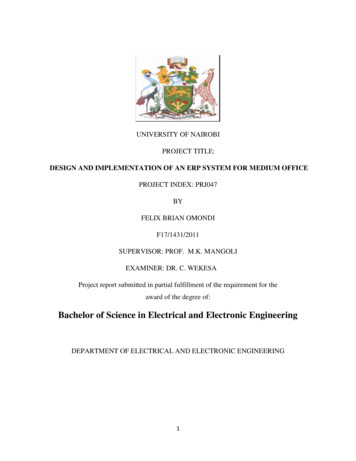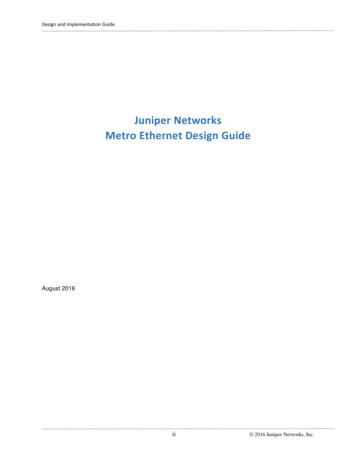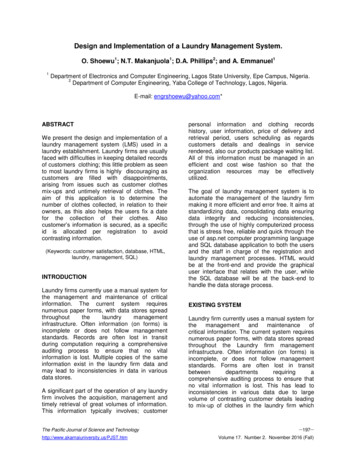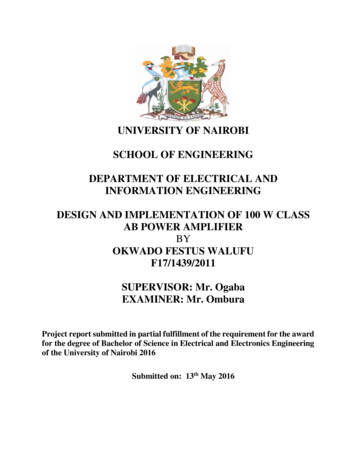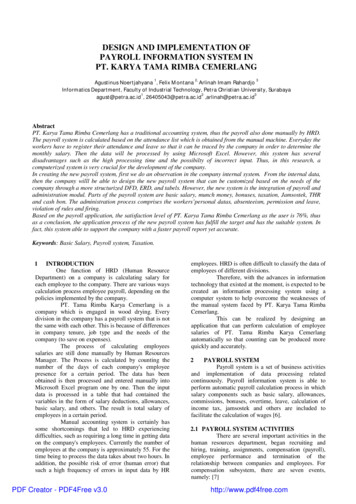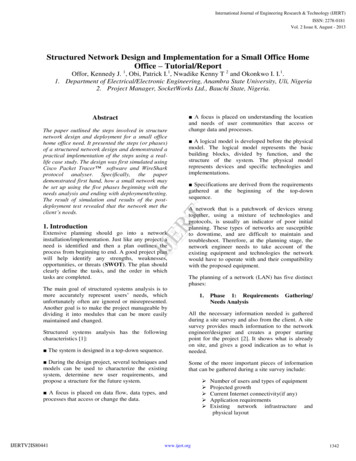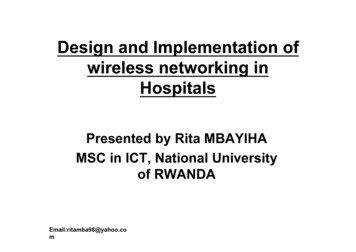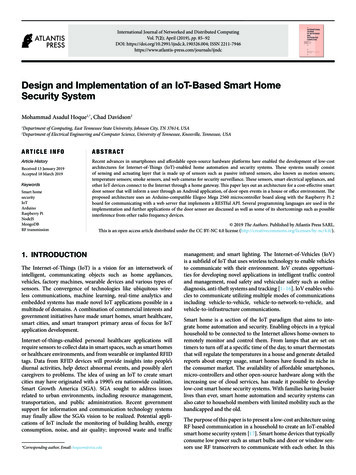
Transcription
International Journal of Networked and Distributed ComputingVol. 7(2); April (2019), pp. 85–92DOI: https://doi.org/10.2991/ijndc.k.190326.004; ISSN jndcDesign and Implementation of an IoT-Based Smart HomeSecurity SystemMohammad Asadul Hoque1,*, Chad Davidson2Department of Computing, East Tennessee State University, Johnson City, TN 37614, USADepartment of Electrical Engineering and Computer Science, University of Tennessee, Knoxville, Tennessee, USA12ARTICLE INFOABSTRACTArticle HistoryRecent advances in smartphones and affordable open-source hardware platforms have enabled the development of low-costarchitectures for Internet-of-Things (IoT)-enabled home automation and security systems. These systems usually consistof sensing and actuating layer that is made up of sensors such as passive infrared sensors, also known as motion sensors;temperature sensors; smoke sensors, and web cameras for security surveillance. These sensors, smart electrical appliances, andother IoT devices connect to the Internet through a home gateway. This paper lays out an architecture for a cost-effective smartdoor sensor that will inform a user through an Android application, of door open events in a house or office environment. Theproposed architecture uses an Arduino-compatible Elegoo Mega 2560 microcontroller board along with the Raspberry Pi 2board for communicating with a web server that implements a RESTful API. Several programming languages are used in theimplementation and further applications of the door sensor are discussed as well as some of its shortcomings such as possibleinterference from other radio frequency devices.Received 13 January 2019Accepted 18 March 2019KeywordsSmart homesecurityIoTArduinoRaspberry PiNodeJSMongoDBRF transmission 2019 The Authors. Published by Atlantis Press SARL.This is an open access article distributed under the CC BY-NC 4.0 license . INTRODUCTIONThe Internet-of-Things (IoT) is a vision for an internetwork ofintelligent, communicating objects such as home appliances,vehicles, factory machines, wearable devices and various types ofsensors. The convergence of technologies like ubiquitous wireless communications, machine learning, real-time analytics andembedded systems has made novel IoT applications possible in amultitude of domains. A combination of commercial interests andgovernment initiatives have made smart homes, smart healthcare,smart cities, and smart transport primary areas of focus for IoTapplication development.Internet-of-things-enabled personal healthcare applications willrequire sensors to collect data in smart spaces, such as smart homesor healthcare environments, and from wearable or implanted RFIDtags. Data from RFID devices will provide insights into people’sdiurnal activities, help detect abnormal events, and possibly alertcaregivers to problems. The idea of using an IoT to create smartcities may have originated with a 1990’s era nationwide coalition,Smart Growth America (SGA). SGA sought to address issuesrelated to urban environments, including resource management,transportation, and public administration. Recent governmentsupport for information and communication technology systemsmay finally allow the SGA’s vision to be realized. Potential applications of IoT include the monitoring of building health, energyconsumption, noise, and air quality; improved waste and traffic*Corresponding author, Email: hoquem@etsu.edumanagement; and smart lighting. The Internet-of-Vehicles (IoV)is a subfield of IoT that uses wireless technology to enable vehiclesto communicate with their environment. IoV creates opportunities for developing novel applications in intelligent traffic controland management, road safety and vehicular safety such as onlinediagnosis, anti-theft systems and tracking [1–16]. IoV enables vehicles to communicate utilizing multiple modes of communicationsincluding vehicle-to-vehicle, vehicle-to-network-to-vehicle, andvehicle-to-infrastructure communications.Smart home is a section of the IoT paradigm that aims to integrate home automation and security. Enabling objects in a typicalhousehold to be connected to the Internet allows home-owners toremotely monitor and control them. From lamps that are set ontimers to turn off at a specific time of the day, to smart thermostatsthat will regulate the temperatures in a house and generate detailedreports about energy usage, smart homes have found its niche inthe consumer market. The availability of affordable smartphones,micro-controllers and other open-source hardware along with theincreasing use of cloud services, has made it possible to developlow-cost smart home security systems. With families having busierlives than ever, smart home automation and security systems canalso cater to household members with limited mobility such as thehandicapped and the old.The purpose of this paper is to present a low-cost architecture usingRF based communication in a household to create an IoT-enabledsmart home security system [17]. Smart home devices that typicallyconsume low power such as smart bulbs and door or window sensors use RF transceivers to communicate with each other. In this
86M.A. Hoque and C. Davidson / International Journal of Networked and Distributed Computing 7(2) 85–92paper, an inexpensive architecture is proposed for a smart doorsensor that will utilize an Elegoo Mega 2560 microcontroller board,Raspberry Pi 2, a web server, and an Android application.PC server that also implemented a MATLAB-GUI platform to control the temperature, lights, and fans. The PIR sensor also acted as asecurity component by detecting possible intrusions and setting offa buzzer to alert the residents.2. RELATED WORKHowedi et al. [23] proposed a low-cost smart home system builtupon a similar architecture using the Arduino Uno board, PIRsensors, DHT11 temperature sensors, INA219 high side DC current sensor and servo motors that control doors and windows.The Arduino IDE is used to implement the control and monitoring module of the system while the MIT App Inventor is used todevelop a simple Android application.Prior work in IoT-enabled home security system has proposedarchitectures that focused on the use of low-cost open-source hardware components like the Arduino and Raspberry Pi MCU boardsand a combination of sensors. Passive Infrared (PIR) sensors areused to detect motion and can work in sync with a webcam thatcaptures images to alert users of trespassing.Kodali et al. [18] describe a cost-effective wireless home securityand automation system based on the TI-CC3200 LaunchPad: abattery-powered Microcontroller Unit (MCU) with built-in Wi-Ficonnectivity. PIR motion sensors are placed at the entrances to abuilding and connect to a digital input–output pin of the MCU.The MCU is programmed using Energia Integrated DevelopmentEnvironment (IDE) and Wi-Fi enabled. Kodali et al.’s configuration allows mobile phones without Internet connectivity to receivesecurity alerts and control IoT devices connected to the microcontroller. Tanwar et al. [19] describe an inexpensive home securitysystem that implements a real-time email alert system. The systemuses a PIR module and a Raspberry Pi MCU. Security camerasand PIR sensors are connected to the Raspberry Pi via USB portsand general purpose input/output pins respectively. The systemassumes that homes have Internet access; it uses the Internet tosend e-mails to the resident in real-time. The system’s intrusiondetection logic identifies motion by comparing signal inputs fromthe PIR sensors with their previous values. When current and previous signals differ, the security camera captures an image that isstored temporarily on the Raspberry Pi and then automaticallye-mailed to the resident.Gupta and Chhabra [20] describe a cost-effective Ethernet-basedsmart home system for monitoring energy consumption, smokeand temperature levels and detecting trespassing. This system usesthe Arduino-certified Intel Galileo 2nd generation microcontrollerboard. Temperature, smoke and PIR sensors are connected directlyto the microcontroller, while four 220 V devices are connected viaa relay module. An android based mobile app that connects to theIntel Galileo-based server over the Internet allows users to toggleswitching devices by tap-to-touch or voice commands throughGoogle API speech recognition tools.Piyare et al. [21] present a Bluetooth-based home automationsystem where an Android cell phone running a Python scriptcommunicates with an Arduino BT board with digital and analoginput/output ports to which sensors and appliances are connected.The smartphone application has a toggle on and off feature for eachdevice. However, Bluetooth connectivity between the smartphoneand the Arduino BT board required a range of 50 m or less within aconcrete building and mobile platforms other than Symbian do notsupport the Pyhton application.Behera et al. [22] designed and implemented a real-time smarthome automation system using an Arduino Uno board along withan Arduino Wi-Fi Shield and a PC home server. A PIR or motionsensor, an light dependent resistor and an LM35 temperaturesensor were used to collect data which was made available on thePanwar et al. [24] implemented the Eyrie smart home automationsystem using the Raspberry Pi 3 MCU as the central hub. Theirproposed architecture connected several Arduino Nano boardslocated around the house to various types of sensors and NRF24Ltrans-receivers that eliminated the need for Ethernet or Wi-Fi connectivity. Mosquito Broker, an open-source message broker usedfor relaying messages to the Raspberry Pi 3, operates using theDebian OS. Eclipse SmartHome framework was used to implementa web interface and a smartphone app for end-users.In Baraka et al. [25], a home automation system with smart taskscheduling is developed making use of wireless ZigBee to connectappliances and wired X10 technology to connect light and switchmodules to an Arduino microcontroller. An Ethernet shield mountedon the Arduino MCU allows communication between Arduino anda web-based Android application which is then used to remotelyadd and manage devices and view recommended scheduling.ShariqSuhail et al. [26] implemented a prototype for smart homesecurity system that uses PIR sensors for intrusion detection, MQ2sensors for detecting smoke and gas leaks, LM35 temperature sensors as input to an Arduino Mega 2560. A buzzer, LCD, LED stripand a Global System for Mobile communication (GSM) module areoutputs to this MCU board while a Raspberry Pi 2 board is usedto include a webcam that captures images upon motion detection.GSM, a wireless technology interfaces with the Arduino Mega tosend SMS notifications and calls to the user’s cell phone wheneverpotential intrusion, smoke or gas leak is detected.In Gunputh et al. [27], a similar architecture utilizes an ArduinoMega 2560 board with a Wi-Fi module to implement a voice- controlled smart home system. The Elechouse V3 voice recognitionmodule allows users to send voice commands to adjust lighting,open or close windows and control a folding bed.Vineeth’s et al. [28] voice-controlled secure eHome also make use ofthe V3 voice recognition module but use an RF module instead ofWi-Fi for wireless communication between an Arduino UNO andRaspberry Pi MCUs. The Raspberry Pi supports sensor connectivity to the Internet so all sensory data can be logged onto a Googlespreadsheet. There is no implementation of a mobile or web app thusconfining the controlling of this system to the location of the mic.Sunehra et al. [29] propose two schemes for a speech-based homeautomation system. The first scheme uses HC-05 Bluetooth modulealong with Arduino Bluetooth controller mobile application tocontrol appliances when inside the house. GSM/GPRS technologyis used to remotely control appliances and receive SMS alerts forpossible intrusion detections. The ARM11 Raspberry Pi board actsas the central hub for receiving voice commands though the HC-05
M.A. Hoque and C. Davidson / International Journal of Networked and Distributed Computing 7(2) 85–9287Bluetooth module and connects to a PIR sensor, relays, a Wi-Firouter and a webcam.3. SYSTEM ARCHITECTURE AND DESIGN3.1. Devices and Sensors Elegoo Mega 2560 board (or Arduino). RF receiver–transmitter pair (433 Hz). Magnetic reed switch. Raspberry Pi 2. Female-to-Female–Female-to-Male Jumper Cables. Android phone or emulator.3.2. SchematicsFigure 1 presents a diagram of the pinout of the Raspberry Pi 2attached to an RF Receiver. The RF Receiver has leads to ground,a 5 V power supply, and to pin 13 on the Raspberry Pi (used inOpenDoor.cpp in repository). Note that there is a second Data pinthat is not to be utilized in this project and an antenna (not pictured) was formed out of rolled aluminum foil.Figure 2 describe the schematics for wiring the Elegoo Mega boards.In Figure 2, a magnetic reed switch and RF 433Hz transmitter isattached to the Mega 2560 board. The ordering of the wires do notmatter for the reed switch. One wire leads to ground and for the codelocated in the repository, pin 2 on the Mega 2560 board is where theother wire will lead. The RF transmitter has leads to ground, a 5 Vpower supply, and a lead to pin 10 on our board. The antenna usedfor this project is a simple rolled piece of aluminum foil.Figure 2 Mega 2560 board with magnetic reed switch and RF transmitterdiagram.3.3. System ArchitectureFigure 3 describes the overall architecture of the smart home securitysystem. Figure 4 shows the flow diagram of data communication.Figure 3 System architecture for IoT-based smart home security.Figure 1 Raspberry Pi 2 pinout diagram with RF receiver wiring.Each of the following subsections provide a detailed explanation ofhow the devices communicate with each other. A simple overviewof the system architecture will help understand why the sectionshave been laid out
and the Arduino BT board required a range of 50 m or less within a concrete building and mobile platforms other than Symbian do not support the Pyhton application. Behera et al. [22] designed and implemented a real-time smart home automation system using an Arduino Uno board along with an Arduino Wi-Fi Shield and a PC home server. A PIR or motion
